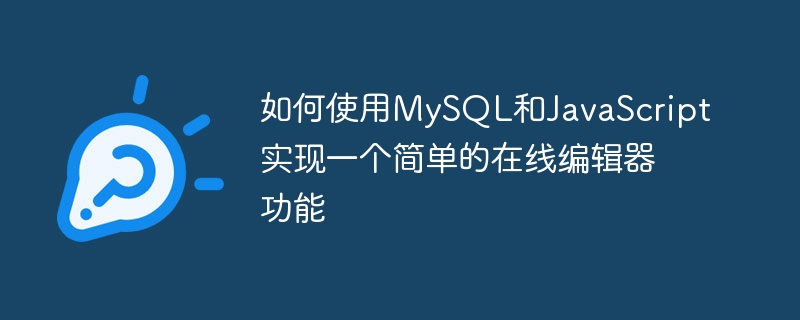

For example, "How to use MySQL and JavaScript to implement a simple online editor function"
With the rapid development of the Internet, more and more applications need to be online Editor to support users in writing and editing text, code, and various files. This article will introduce how to use MySQL and JavaScript to implement a simple online editor function and provide specific code examples.
1. Database design
The online editor function needs to store files created by users, so a database is needed to store related information. We use MySQL as the database, create a database named "files" in MySQL, and create a table named "documents" in the database. The structure of the table is as follows:
CREATE TABLE `documents` ( `id` INT(11) NOT NULL AUTO_INCREMENT, `title` VARCHAR(255) NOT NULL, `content` TEXT NOT NULL, PRIMARY KEY (`id`) );
2. Backend Implementation
const express = require('express');
const bodyParser = require('body-parser');
const mysql = require('mysql');
const app = express();
app.use(bodyParser.urlencoded({ extended: true }));
app.use(bodyParser.json());
const connection = mysql.createConnection({
host: 'localhost',
user: 'root',
password: 'password',
database: 'files'
});
connection.connect();The code is as follows:
// 创建文档
app.post('/documents', (req, res) => {
const { title, content } = req.body;
const query = `INSERT INTO documents (title, content) VALUES ('${title}', '${content}')`;
connection.query(query, (error, results) => {
if (error) throw error;
res.json({ id: results.insertId });
});
});
// 获取所有文档
app.get('/documents', (req, res) => {
connection.query('SELECT * FROM documents', (error, results) => {
if (error) throw error;
res.json(results);
});
});
// 根据ID获取文档
app.get('/documents/:id', (req, res) => {
const { id } = req.params;
const query = `SELECT * FROM documents WHERE id = ${id}`;
connection.query(query, (error, results) => {
if (error) throw error;
if (results.length > 0) {
res.json(results[0]);
} else {
res.status(404).json({ error: 'Document not found' });
}
});
});
// 更新文档
app.put('/documents/:id', (req, res) => {
const { id } = req.params;
const { title, content } = req.body;
const query = `UPDATE documents SET title = '${title}', content = '${content}' WHERE id = ${id}`;
connection.query(query, (error, results) => {
if (error) throw error;
res.json({ success: true });
});
});
// 删除文档
app.delete('/documents/:id', (req, res) => {
const { id } = req.params;
const query = `DELETE FROM documents WHERE id = ${id}`;
connection.query(query, (error, results) => {
if (error) throw error;
res.json({ success: true });
});
});
// 启动服务器
app.listen(3000, () => {
console.log('Server started on http://localhost:3000');
});3. Front-end implementation
<!DOCTYPE html>
<html>
<head>
<title>Online Editor</title>
<script src="https://cdn.jsdelivr.net/npm/vue/dist/vue.js"></script>
<script src="https://cdn.jsdelivr.net/npm/axios/dist/axios.min.js"></script>
</head>
<body>
<div id="app">
<h1>Online Editor</h1>
<form @submit.prevent="saveDocument">
<input type="text" v-model="title" placeholder="Title" required>
<textarea v-model="content" placeholder="Content" required></textarea>
<button type="submit">Save</button>
</form>
<ul>
<li v-for="document in documents" :key="document.id">
<a :href="'/documents/' + document.id">{{ document.title }}</a>
<button @click="deleteDocument(document.id)">Delete</button>
</li>
</ul>
</div>
<script src="editor.js"></script>
</body>
</html>new Vue({
el: '#app',
data: {
title: '',
content: '',
documents: []
},
methods: {
async saveDocument() {
try {
const response = await axios.post('/documents', {
title: this.title,
content: this.content
});
this.documents.push({ id: response.data.id, title: this.title });
this.title = '';
this.content = '';
} catch (error) {
console.error(error);
}
},
async deleteDocument(id) {
try {
await axios.delete(`/documents/${id}`);
this.documents = this.documents.filter(document => document.id !== id);
} catch (error) {
console.error(error);
}
},
async fetchDocuments() {
try {
const response = await axios.get('/documents');
this.documents = response.data;
} catch (error) {
console.error(error);
}
}
},
mounted() {
this.fetchDocuments();
}
});4. Testing and running
$ npm install express body-parser mysql
$ node server.js
Summary:
This article implements a simple online editor function through MySQL and JavaScript, including basic operations such as addition, deletion, modification, and query. By separating the front and back ends, the front end uses Vue.js to implement a simple interactive interface, and the back end uses Express and MySQL to process data.
The above is a detailed introduction and code example on how to use MySQL and JavaScript to implement a simple online editor function. I hope this article can help you understand and use the online editor.
The above is the detailed content of How to use MySQL and JavaScript to implement a simple online editor function. For more information, please follow other related articles on the PHP Chinese website!
